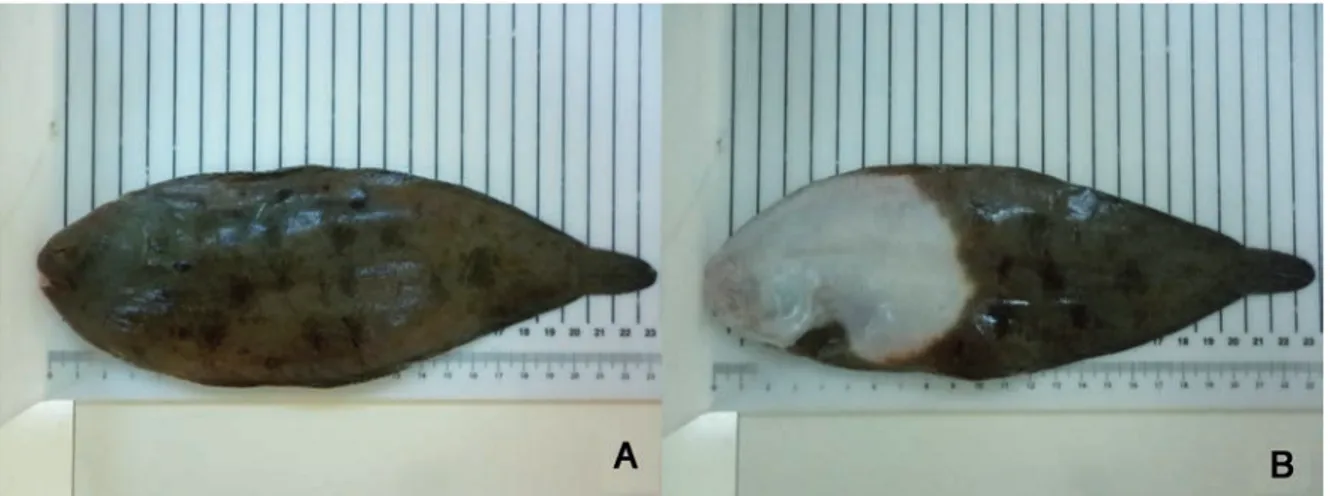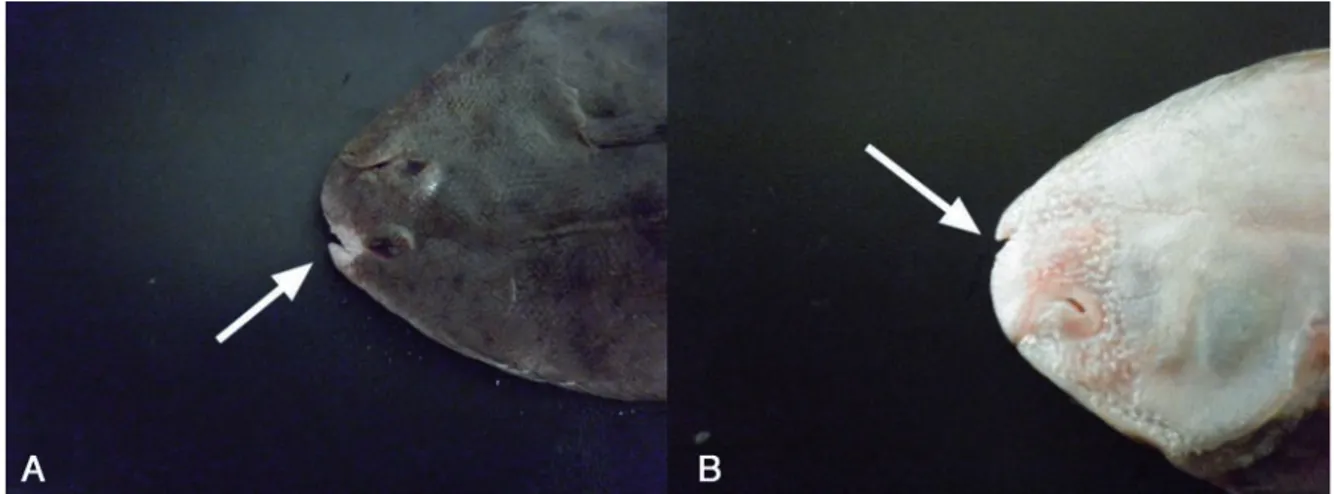Introduction
The flatfishes (Order: Pleuronectiformes), also called the Heterosomata, differ from other fishes because instead of standing vertically in the water they lie horizontally on the bottom on their blind side (Gibson, 2005). It is known that all flatfishes begin their life as pelagic and with bilaterally symmetry, however, during larval development, flatfishes undergo a prominently ontogenetic metamorphosis where
one eye migrates dextral (eyes and colour on the right side) or sinistral (eyes and skin colour on the left side) according to genus and species (Diaz de Astarloa, 1995). These deviations also occur in various external and internal structures including several bones of the skull, jaw shape and dentition, development lateral body musculature, lateral-line development on each side of the body and coloration on the ocular and blind sides (Chapleau, 1993). Malpigmentation, also known as color anomalies in the skin of flatfishes, can be termed by ocular and/or blind side differently: 1) Hypomelanosis (pseudoalbinism) refers to a full or partial lack of pigmentation on the ocular side, 2) Hypermelanosis has been characterized by abnormal Reçu le 7 avril 2015 ; accepté après révision le 27 août 2015.
Received 7 April 2015; accepted in revised form 27 August 2015. Cah. Biol. Mar. (2016) 57 : 85-87
Occurrence of colour abnormalities and morphological
aberration in common sole Solea solea (L., 1758) captured
from the Aegean Sea
Hasan CERİM, Murat ÇELİK and Sercan YAPICI*Muğla Sıtkı Koçman University, Faculty of Fisheries, 48000, Kötekli, Muğla, Turkey *Corresponding author E-mail: sercanyapici@mu.edu.tr
Abstract: Occurrence of malpigmentation, including hypomelanosis and ambicoloration, and morphological abnormality were described in Solea solea caught from the Güllük Bay (South West of Turkey). A single specimen of S. solea was reported showing in the blind side a 60% of the coloration found in the ocular side, which was slightly hypomelanistic. Résumé : Anomalies pigmentaires et morphologiques sur un spécimen de sole commune Solea solea (Linné, 1758) capturé
en Mer Egée. La présence d’anomalies pigmentaires et morphologiques est décrite chez Solea solea capture dans la Baie
de Güllük (sud-ouest de la Turquie). Un unique spécimen est signalé, caractérisé par une pigmentation sur environ 60% de la surface de son côté aveugle identique à celle du côté visible, celui-ci étant légèrement sous pigmenté.
86 MALPIGMENTATION AND MORPHOLOGICAL ABNORMALITY OF COMMON SOLE pigmentation on the blind side, and 3) Having full or partial
ocular-like coloration on the both sides is known as ambicoloration or double coloured. As well as conditions associated with skeletal deformities, colour anomalies from pseudoalbinism to ambicoloration are well-known and they are a common problem in aquaculture. However abnormal pigmentation is not limited to reared fishes because abnormalities are reported evenly in natural populations (Gibson, 2005). Although incidence of malpigmentations in natural populations may be difficult to estimate because abnormally pigmented individuals are permanently under predation (Koshiisi et al., 1991), it has been documented both in aquaculture and natural environment by numerous authors (e.g. Kanazawa, 1993; Diaz de Astarloa, 1995; Shields et al., 1999; Venizelos & Benetti, 1999; Bolker & Hill, 2000).
Material and Methods
On September 21th 2014, a single malpigmented female specimen of Solea solea (Linnaeus, 1758) with the hooked dorsal fin (Figs 1 & 2) was collected using a trammel net with a mesh size of 45 mm from Güllük Bay (37°12´N-27°33´E) over a sandy bottom at a depth of 35 m approximately. The specimen was then measured for total length (cm), weighted (g) and photographed and then conserved with 4% buffered formalin. Ratio of malpigmentation was determined by naked eye.
Results and Discussion
Total length (cm) and weight (g) was as 23.4 cm and 134.53 g respectively. The collected specimen had two different types of skin colour and one morphological abnormality; hypomelanosis on the ocular side (Fig. 2a) and
ambicoloration on the blind side (Fig. 1b), and hooked dorsal fin (Fig. 2b). The blind side was approximately 60%-pigmented with coloration similar to that of the ocular side and had also white spot on the ocular side of hooked dorsal fin (Fig. 2a). Although, there are rare and considerable reports about both hypermelanosis and hypomelanosis in wild common sole (Paris & Quignard, 1968; Akyol & Şen, 2012), any report has been made on dorsal fin deformity in this species. Then to date our finding represents the first occurrence in literature of two kind of malpigmentation with hooked dorsal fin for any flatfish in Aegean Sea.
A number of environmental (i.e. contamination), nutritional (i.e. deficiency of PUFA or vitamin A) and neurological (i.e. endocrine system) factors lie behind malpigmentation (Boglino et al., 2013 & 2014). In literature, these anomalies in natural population are mostly correlated with incomplete migration of the eye, because unsuccessful eye migration (in which mostly the migrating eye stops on middorsal ridge) can result in ambicoloration and overhung by the anterior hooked end of the dorsal fin (Uluturk et al., 2015). Although the present study did not intended to discuss the causes of these abnormalities, it can be hypothesised that these anomalies may be associated with environmental and/or anthropogenic causes. Güllük Bay, indeed, is a potentially important area for aquaculture along the Turkish Aegean coasts and then affected by different kinds of pollution originated by domestic waste water, touristic activities, loads brought by the Saray Stream, loads produced by aquaculture activities and Güllük Port activities and mining transferred from Güllük Port activities and mining transferred from Güllük Port to the open sea (Dalman et al., 2006).
Many studies have been focused to find the mechanisms underlying malpigmentation in culture or laboratory conditions were carried on; however, no research has been performed on natural population of flatfishes. Therefore,
H. CERİM, M. ÇELİK, S. YAPICI 87
further experimental research to understand this mechanisms are strongly encouraged.
Acknowledgements
We would like to thank Aydemir Avcı and Yılgör Karakoyun from the Boğaziçi Fisheries Cooperative for providing specimen. Also, we thank to Dr. Daniela Giannetto from Muğla Sıtkı Koçman University for revising English of the manuscript. Finally, we would like to thank the anonymous referees for valuable comments and English corrections.
References
Akyol O. & Şen H. 2012. First record of abnormal pigmentation
in a wild common sole, Solea solea L., from the Aegean Sea.
Turkish Journal of Veterinary and Animal Sciences, 36:
727-729.
Boglino A., Wishkerman A., Darias M.J., Andree K.B., de la Iglesia P., Estevez A. & Gisbert E. 2013. High dietary
arachidonic acid levels affect the process of eye migration and head shape in pseudoalbino Senegalese sole Solea
senegalensis early juveniles. Journal of Fish Biology, 83:
1302-1320.
Boglino A., Darias M.J., Andree K.B., Estévez A. & Gisbert E. 2014. The effects of dietary arachidonic acid on bone in flatfish
larvae: the last but not the least of the essential fatty acids.
Journal of Applied Ichthyology, 30: 643-651.
Bolker J.A. & Hill C.R. 2000. Pigmentation development in
hatchery-reared flatfishes. Journal of Fish Biology, 56: 1029-1052.
Chapleau F. 1993. Pleuronectiform relationships: a cladistic
reassessment. Bulletin of Marine Science, 52: 516-540.
Dalman Ö., Demirak A. & Balcı A. 2006. Determination of
heavy metals (Cd, Pb) and trace elements (Cu, Zn) in sediments and fish of the Southeastern Aegean Sea (Turkey) by atomic absorption spectrometry. Food Chemistry, 95: 157-162.
Diaz de Astarloa J.M. 1995. Ambicoloration in two flounders,
Paralichthys patagonicus and Xystreuris rasile. Journal of Fish Biology, 47: 168-170.
Gibson R.N. 2005. Flatfishes: Biology and Exploitation. Fish and
Aquatic Resources Series, vol. 9. Blackwell Publishing, Oxford. 416 pp.
Kanazawa A. 1993. Nutritional mechanisms involved in the
occurrence of abnormal pigmentation in hatchery-reared flatfish. Journal of the World Aquaculture Society, 24: 162-166.
Koshiisi Y., Itano H. & Hirota Y. 1991. Artificial stock-size
improvement of the flounder, Paralichthys olivaceus: present status of technological achievement. In: Proceedings of the
Seventeenth US-Japan Meeting on Aquaculture (R.S. Svrjcek
Ed.), pp. 33-43. NOAA Technical Report NMFS 102.
Paris J. & Quignard J.P. 1968. Quelques cas d’ambicoloration
et d’albinisme chez Solea vulgaris (Quensel). Revue des
Travaux de l’Institut des Pêches Maritimes, 32: 507-510.
Shields R.J., Gara B. & Gillespie M.J.S. 1999. A U.K.
perspective on intensive hatchery rearing methods for Atlantic halibut (Hippoglossus hippoglossus). Aquaculture, 176: 15-26.
Uluturk E., Bayhan B., Filiz H., Acarli D. & Irmak E. 2015.
Abnormalities in the wedge sole Dicologlossa cuneata (Moreau, 1881) and Black Sea turbot Scophthalmus maeoticus (Pallas, 1814) from Turkish Seas. Journal of Aquaculture
Engineering and Fisheries Research, 1: 98-103.
Venizelos A. & Benetti D.D. 1999. Pigment abnormalities in
flatfish. Aquaculture, 176: 181-188.

